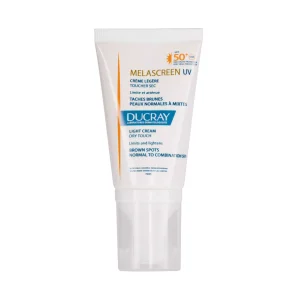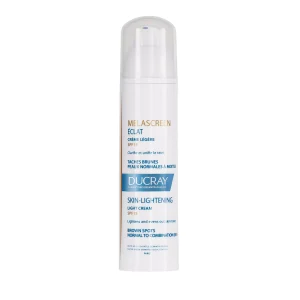
Among skin problems, there’s one that’s often overlooked or misunderstood: melasma. Often referred to as the “mask of pregnancy”, melasma is a form of hyperpigmentation that affects individuals of all genders and backgrounds, whatever their stage of life. This skin condition, caused by hormonal imbalances, goes beyond its aesthetic implications and affects self-esteem, mental health and quality of life. Read this article from The Dermo Lab to discover the complex layers of melasma and explore the path to understanding and treating hormonal hyperpigmentation.
What are the symptoms of melasma?
- Dark spots on the face
Melasma causes hyperpigmentation or discolored spots that are darker than the surrounding skin. Skin appears blotchy and uneven, with irregular edges on discolored patches.
- Appears on sun-exposed skin
Melasma develops on areas of skin exposed to the sun, most often the face. Melasma usually appears above the upper lip, on the cheeks, nose and forehead, but it can develop anywhere on the face. It can also appear on the chest, arms and upper back, but less frequently.
- Symmetrical
The key factor in melasma is that it generally appears symmetrically on the face. You’ll notice identical spots on both cheeks, or spots that have developed evenly on the nose or forehead.
- Can cover a large area
Melasma spots may come together to form one or more larger areas of hyperpigmentation.
- Color and intensity may vary
Discoloration can range from slightly darker than normal skin color to extremely dark. Depending on skin tone and the severity of melasma, discoloration may be light brown or almost black. In people with darker skin tones, melasma can take on a grey-blue hue.
- Painless
These areas of discoloration don’t hurt, burn or itch. In fact, you won’t notice anything different about these areas of skin, apart from the fact that they’re discolored.
What is the cause of melasma?
The exact cause of melasma is not fully understood, but is thought to be influenced by a combination of factors, including:
1- The sun factor: the main culprit
The sun plays an important role in the history of melasma. We know that ultraviolet (UV) rays influence melanin production. When the skin is exposed to the sun, it reacts by producing more melanin to protect itself from UV damage. In melasma sufferers, this natural defense mechanism can backfire, as it exacerbates existing pigment irregularities.
It’s a bit like adding fuel to fire. Not only do the sun’s rays darken existing melasma spots, they can also trigger new ones. That’s why sun protection is an essential part of any melasma management strategy. Broad-spectrum sunscreens, protective clothing and shade-seeking are essential tools for preventing melasma from worsening.
2- Hormonal imbalance
Hormonal imbalances play a key role in the development of melasma. Fluctuations in estrogen and progesterone levels, which often occur during pregnancy, oral contraceptive use and hormone therapy, can trigger an overproduction of melanin, the pigment responsible for skin color. This increase in melanin leads to the formation of stubborn dark spots that are notoriously difficult to treat.
3- Genetics
Family history and genetics can play a role in the likelihood of developing melasma.
4- Cosmetics
The use of certain cosmetics, skin care products or perfumes that cause skin irritation or inflammation can trigger melasma.
What is the emotional impact?
Beyond the physical aspects, melasma can have a significant impact on emotional well-being. The visible nature of discolored spots can lead to self-esteem problems, social embarrassment and even anxiety. The management of melasma goes beyond topical treatments and extends to psychological coping mechanisms and emotional support.
Managing melasma begins with a thorough understanding of the triggering and contributing factors. While completely eradicating melasma can be difficult, there are effective treatments that can help lighten discoloration and improve skin appearance.
What are the ways for treating hormonal hyperpigmentation?
Treating melasma requires a multi-faceted approach, addressing both the hormonal and pigmentary aspects of the disease. Here are a few cutting-edge treatment strategies that have shown promising results:
1- Sun protection: a non-negotiable habit
Perhaps the most crucial aspect of melasma management is sun protection. Wearing a high SPF broad-spectrum sunscreen every day, combined with protective clothing and accessories, helps protect the skin from UV rays. Regular sun protection not only prevents melasma from worsening, but also protects the skin from further sun damage.
Our selection of sunscreens:
Ducray Melascreen UV Light Cream SPF50+
Eau Thermale Avène Very High Protection Fluid SPF 50+
Eau Thermale Avène Very High Protection Cream SPF50+
2- Topical treatments: An important line of defense
Prescription creams containing ingredients such as hydroquinone, tretinoin, corticosteroids and azelaic acid are commonly prescribed. These ingredients work by inhibiting melanin production, promoting cell renewal and reducing inflammation. However, patience is required, as visible results may take several weeks to appear.
Here are 2 creams that contain active depigmenting ingredients and are ideal for reducing and unifying skin tone.
Ducray Melascreen Depigmenting Intensive Care (intensive care for 3 to 6 months)
Ducray Melascreen Eclat Light Cream SPF15 (as a follow-up or right from the start, because it lightens and evens your skin tone)
3- Procedures for progress
For those seeking faster improvement, dermatological procedures offer promising options. Chemical peels, microdermabrasion and laser therapy can effectively target excess pigment and promote a more even skin tone. These procedures work by gently exfoliating the skin and encouraging the growth of new, healthier skin.
4- Oral medications
In some cases, oral medications such as tranexamic acid may be prescribed to help control melanin overproduction. These drugs act internally to limit pigmentation irregularities.
It’s important to recognize that every melasma experience is unique. What works for one person may not give the same results for another. It’s essential to consult a dermatologist for an accurate diagnosis and a suitable treatment plan. A healthcare professional can assess the severity of the condition, skin type and any underlying factors, then recommend the most appropriate course of action.
Conclusion
While melasma can be a daunting challenge, understanding its hormonal roots and the range of effective treatment options enables individuals to take control of their skin health. By adopting a holistic approach combining appropriate skin care, sun protection and professional interventions, those affected by melasma can confidently embark on the path to a clearer, more radiant complexion. Remember, melasma is important, but so is your journey to more confident skin.













